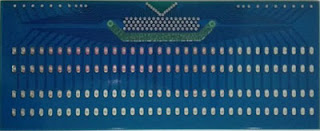Reflow soldering is the modern mechanism for assembling most printed circuit boards today. It enables mass production at a very rapid rate by allowing placement of the components to be separated from the actual soldering process. This process is somewhat different from how somebody would solder by hand. When you’re hand soldering you’re treating one component individually and applying heat to each component at a time so the technique has to be a little bit different.
Reflow soldering is the most common method of attaching surface mount components to a circuit board, although it can also be used for through-hole components by filling the holes with solder paste and inserting the component leads through the paste. Because wave soldering can be simpler and cheaper, reflow is not generally used on pure through-hole boards. When used on boards containing a mix of SMT and THT components, through-hole reflow allows the wave soldering step to be eliminated from the assembly process, potentially reducing assembly costs.
The goal of the reflow process is to melt the solder and heat the adjoining surfaces, without overheating and damaging the electrical components. In the conventional reflow soldering process, there are usually four stages, called "zones", each having a distinct thermal profile: preheat, thermal soak, reflow, and cooling.












































